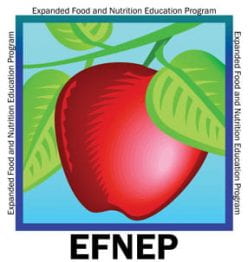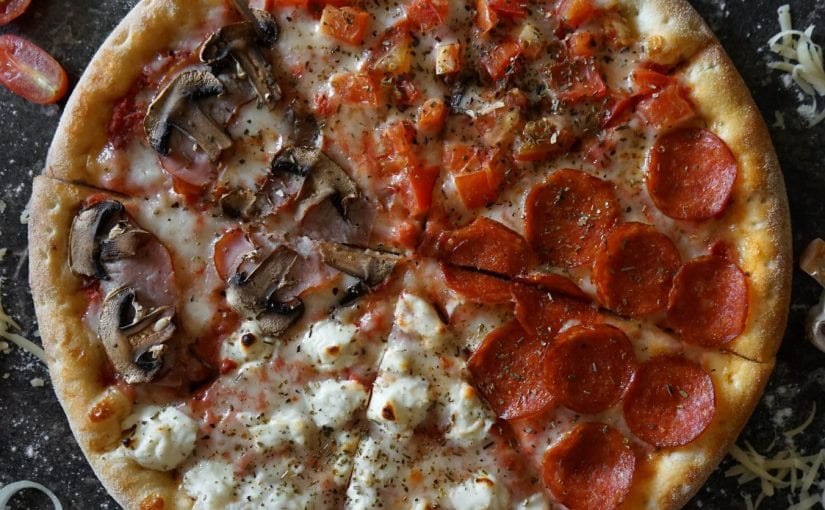National Pizza Day is celebrated each year on February 9th. There are other pizza related holidays: National Pizza Party Day, National Pepperoni Pizza Day, even a World Pizza Day, and let’s not forget the World Pizza Games with events like “Largest Dough Stretch” and “Fastest Pizza Box Folding.”
There are pizza museums, pizza flavored ice cream, a Pizza Theorem in geometry, and a pizza was delivered to the International Space Station in 2001. The pizza industry worldwide is about $145 billion; about a third of that is in the U.S. alone! Pizza is so well loved by so many, it’s pretty much Pizza Day most any day.
History of Pizza
The origins of pizza date back at least 2500 years, when the ancient Greeks, Romans, and Egyptians were eating flat breads with toppings—usually olive oil and spices, so more like focaccia—but the first known usage of the word “pizza” was in 997 AD in a text source from southern Italy.
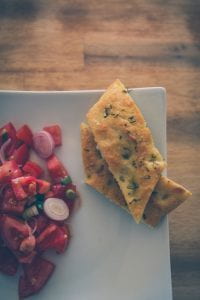
Through the 18th century, pizza was a cheap street food sold to the poorest laborers—tomatoes were cheap because Europeans mistakenly believed that they were poisonous because the plant is in the nightshade family. Legend has it that it wasn’t until 1889, when Queen Margherita was happily served some while visiting Naples after unification, that pizza was given status as a wholesome food.
Italian immigrants brought pizza with them to the U.S. in the early 1900s, but it didn’t really gain in popularity in the U.S. until the 1950s after soldiers returned from WWII. A decade later, the first frozen pizzas were available in supermarkets.
Is Pizza Healthy?
Pizza is not inherently unhealthy. Cheese, tomato sauce, and bread can all be part of a healthy eating pattern. Rather, it is the size of the portion that we eat, and the proportions of the five food groups in the pizza slice we are eating, that can be out of balance, making it a less healthy choice. Let’s look closer.
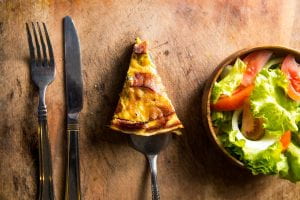
The crust
One thing we can do with the crust to make it a healthier choice is to make it whole grain. Whole grains contain fiber, which refined—and enriched—flours and grains don’t. They also contain more vitamins and minerals.
If your local pizza place doesn’t offer a whole wheat option, try making your pizza at home. Ready-made whole wheat crusts and/or ready-made whole wheat pizza dough can be bought at many supermarkets. If you’d like to make it at home from scratch, give this Whole Wheat Pizza Dough recipe a try.
The sauce
Tomatoes are a good source of Vitamin C, and, like most vegetables and fruits, are naturally low in fat, calories, and sodium. But prepared tomato and pasta sauce—whether canned, bottled, or made by your local pizza place–can be very high in sodium! Check the labels and aim for something with less than 115mg per serving, or control your ingredients by making it at home. Try this simple marinara recipe that begins with canned tomatoes.
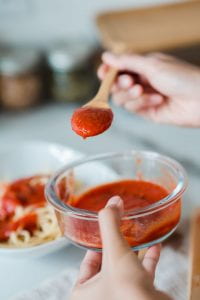
The tomatoes used in sauce often have their skins and seeds removed—unless it is a chunky sauce—and so prepared tomato sauce may not a great source of fiber. Be sure to add some of your favorite veggies (or fruit, even) as toppings to boost the fiber—and health factor—in your pizza.
The cheese
Mozzarella cheese, like most cheeses, is relatively high in fat and calories, and the fat is the less heart-healthy saturated fat. So please skip the “extra cheese” pie! When making at home, choose a part-skim mozzarella and measure an appropriate amount.
Cheese can also be high in sodium. The amount of added salt varies from manufacturer to manufacturer, so be sure to look at the label before purchasing. You might find the lower fat version is higher in sodium to help make up some of the flavor, and you also might find that fresh mozzarella is lower in sodium than packaged.
For an overview of types of cheeses, take a look at Penn State Extension’s “Selecting Cheese for Health” article.

The toppings
Select your toppings wisely to keep your pizza a healthy choice. Popular meat toppings like pepperoni, bacon, and sausage are high in fat, calories, and sodium. Choose a lean meat like chicken breast instead—but not breaded and fried chicken breast.
Low fat, low calorie, high fiber vegetable toppings like pepper, onion, broccoli, mushroom, spinach, fresh tomatoes—there is no limit except your imagination—are excellent choices. Olives are also a popular topping, and while their fat is the healthier unsaturated fat, they are still high in fat overall so limit how much you use.
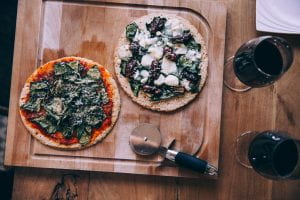
The portion
The main reason pizza can be an unhealthy choice is because we tend to eat too much of it at one meal. Keep your meal in MyPlate balance: half your plate veggies and fruits, ¼ plate grains (whole grain at least half the time), ¼ plate lean protein, and a serving of dairy. Instead of choosing to eat two (or three! or four!!) slices, enjoy one slice and fill up the rest of your plate and your stomach with a green salad or side of vegetables, and have some fruit for dessert.
What else?
Try out these easy homemade pizza recipes that take advantage of breads you might already have at home.
- English Muffin Pizza: a very basic recipe using the microwave. Very kid friendly!
- Mini Veggie Pizza: using English muffins and the oven/broiler
- Tortilla Pizzas: using tortillas and the flavors in tacos.
- Veggie Pizza Pita Pockets: another microwave recipe, good for days you don’t want to heat your kitchen.
- Rice-Crusted Pizza: need a gluten-free recipe? Try the alternative crust in this one.
- Oat! My Tropical Pizza: another gluten free option, swapping yogurt for cheese.
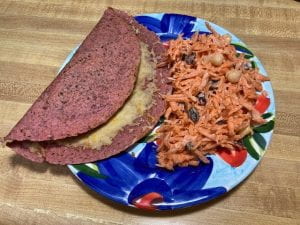
We hope these ideas inspired a nourishing approach to celebrating on February 9th! If you are interested in more healthy cooking tips or nutrition information, or to participate in our free nutrition/cooking classes, visit our website or contact our nutrition educators: Michelle Leveski, mml39@cornell.edu, 518-234-4303 ext. 115, or Kimberly Ferstler, kmf2349@cornell.edu, 518-234-4303 ext. 120
